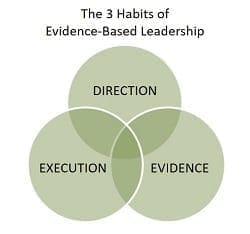The 3 Habits of Evidence-Based Leadership
by Stacey Barr |Evidence-based leadership is not about how to lead. It’s about what to give your attention to as you lead, and what you’re leading your organisation to. It’s not about how to communicate or inspire or direct or engage. It’s about how to use all these attributes to lead your organisation to high-performance.

Organisational performance is one of the few most important outcomes all leaders are responsible for. And how an organisation performs is evidenced by the results it achieves, not by the work it does.
To truly know what results an organisation is achieving, and how it’s getting better at this over time, those results must be measured. Performance measures are evidence of the degree to which important results are occurring over time. Without good performance measures, we have no evidence. With no evidence, we can’t know. If we can’t know, we’re guessing. Evidence-based leaders don’t guess.
Evidence-based leaders give their attention to three habits of high-performance: Direction, Evidence, and Execution. Let’s explore…
EBL Habit 1: Direction is about articulating a measurable strategy.
To be measurable in a meaningful way, a strategy must be results-oriented, understandable to everyone, and ruthlessly prioritised. And then it becomes the kind of strategy people feel compelled to make reality.
EBL Habit 2: Evidence is about setting meaningful performance measures for each strategic goal.
Surprisingly, just about every strategic goal that matters can be made measurable, and measurable in a meaningful way. The most meaningful measures are quantitative, aligned to what matters, and focused on improvement.
EBL Habit 3: Execution is about getting the corporate strategy implemented and the strategic goals achieved.
The best strategy execution, that produces the highest return on effort and investment, uses the leverage of continuous improvement of business processes. It’s not about ‘bolting on’ new capability, it’s about unleashing what’s there.
These three habits are the foundation of how to inspire an organisation to perform better and better.
Leaders give attention to these three high-performance habits to set the direction for the organisation, to monitor its progress, and to decide what change initiatives to invest in.
And giving attention to these habits is not just for leaders. It’s for everyone in the organisation:
- Everyone has to work in ways that help achieve the corporate direction.
- Everyone has to show up to work each day and know that they are contributing to something bigger and more important than their to-do list.
- Everyone has to get involved in tweaking and transforming the organisation so it can better fulfil its mission and realise its vision.
These three habits of high-performance must become organisational habits. And that will only happen when they are habits of its leaders. So inspire your organisation to practice those behaviours of evidence-based leadership and evidence-based management, by first making the habits of high-performance your habits, and then leading everyone else to adopt them too.
DISCUSSION:
What does evidence-based leadership mean to you? How would you recognise it happening around you?
Connect with Stacey
Haven’t found what you’re looking for? Want more information? Fill out the form below and I’ll get in touch with you as soon as possible.
167 Eagle Street,
Brisbane Qld 4000,
Australia
ACN: 129953635
Director: Stacey Barr




